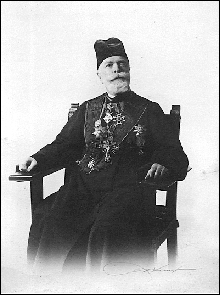|

The
50th Anniversary of the Repose of the “Apostle of South
America,” Protopresbyter Konstantin Izrastsoff
The eve
of the Nativity of the Lord 2002 (6 January 2003 according
to the new calendar) marked the 50th anniversary of the repose
of the “Apostle of South America,” Protopresbyter
Konstantin Izrastsoff of blessed memory. After all-night vigil,
the clergy and parishioners of Holy Trinity Cathedral in Buenos
Aires descended into the crypt of Fr. Konstantin. The grandsons
of Fr. Konstantin, Yurii Georgievich and Nikolai Georgievich,
were present, as was his great-grandson, Ivan Nikolaevich
Izrastsoff. We bring you a short biography of Fr. Konstantin:
Protopresbyter Konstantin Izrastsoff, the son of a priest
in the town of Zadolye, Kashin uezd, Tver guberniya, Fr. Gabriel
Alekseevich Izrastsoff and his wife Anna Petrovna, nee Uspenskaya,
was born on 24 February 1865.
He studied Russian grammar at home under the supervision of
his parents. In 1872, he was placed into Krasnokholm Theological
School in Vesyegonskiy uezd in the same guberniya.
In 1878, Konstantin Gavriilovich enrolled in the 1st year
of Tver Theological Seminary, one of the biggest of such schools
in Russia, where enrollment sometimes reached over 800 students.
Upon the completion of the 6-year seminary program, Konstantin
Izrastsoff proved to be one of the best students, and he was
send on a government stipend to St. Petersburg Theological
Seminary. In 1888, Konstantin finished the Academy with a
Masters of Theology degree.
While still a student of the Academy, he met a girl, Elena
Iosifovna Bouhe, the daughter of Belgian parents, who was
herself born and bred in Russia.
At first, Konstantin served as a psalm-reader in the Orthodox
church at the Russian Imperial Mission in the Hague, Holland.
Elena Iosifovna accepted the Orthodox faith in 1881, and married
Konstantin Gavriilovich.
Konstantin Izrastsoff was that same year ordained as deacon
by His Grace Anthony, Bishop of Vyborg, Rector of St. Petersburg
Theological Academy.
At the same time, there was a vacancy for priest in Buenos
Aires, and the young Fr. Konstantin was ordained to the priesthood
and assigned to that church.
At the time, there were no more than a half-dozen Russian
Orthodox believers in Argentina, scattered throughout the
country in various cities, and the parish in Buenos Aires
consisted exclusively of Greeks, Syrians and Yugoslavians
(Serbs, Montenegrans, Dalmatians, Herzegovinians and Bosnians).
Later they were joined by Bulgarians and Rumanians. The city
of Buenos Aires itself was home to few Orthodox Christians,
but there were many more in the countryside: peddlers and
merchants lived there, farmers and sailors, workers and tradesmen.
It was among them that Fr. Konstantin’s missionary work
began. He often traveled to different cities and to the provinces,
to visit the Orthodox living there.
With God’s help, church life in Argentina established
itself, but the Russian church, housed in a rented building,
frustrated the rector and parishioners. Fr. Konstantin directed
an appeal for funds to the Ministry of Foreign Affairs, but
the Ministry and the Diocesan Administration refused him out
of hand, pleading a lack of funds. But the Chief Procurator
of the Synod of Bishops, K.P. Pobedonosets, sent 18,100 rubles
from the Synodal treasury. This sum went almost entirely into
the purchse of land on Europa Street. Later, using donations
collected by Fr. Konstantin, another parcel of land was purchased
on Calle Brasil, across from Parca Lezama, where the church
now stands in its glory.
Due to a lack of funds, Fr. Konstantin personally traveled
to Russia and undertook collecting donations in various cities,
asking the appropriate permission from the ecclesiastical
and civil authorities.
Upon his return from Russia, Fr. Konstantin immediately began
the construction of the church. The construction was completed
by Fr. Konstantin entirely on donations he collected himself.
A school was established at the church, where children were
taught the Law of God and prayers. Subjects were taught in
the childrens’ own language: Greek children were taught
in Greek, Syrians in Arabic and Slavs in their languages.
In July 1926, Fr. Konstantin was appointed by the Supreme
Ecclesiastical Authority of the Russian Orthodox Church Outside
of Russia as Administrator of South America, but in 1937,
due to health reasons, Protopresbyter asked the Synod of Bishops
to release him from this post, leaving him responsible for
Argentina only, which was granted.
It is worth noting that the Synod of Bishops offered Fr. Konstantin
the first-ever Russian Orthodox See of Argentina. Metropolitan
Anthony (Khrapovitsky) wrote to Fr. Konstantin that, as an
apostle of Orthodoxy in Argentina, he should be consecrated
bishop. But for various reasons, Fr. Konstantin declined this
offer with great gratitude.
The Orthodox church established in Buenos Aires by Fr. Konstantin
was his favorite child, but he also gave material support
to the Cathedral in Sao Paolo in Brazil and the church in
Vila Alpina, the churhc in Montevideo, Uruguay, and Asuncion
in Encarnacion in Paraguay, in Los Pratos in Rio-Grande Sul
in Brazil, Santiago de Chile in Argentina in Misionese and
Chaco in Machagai.
Fr. Konstantin reposed in the Lord on 6 January in Buenos
Aires and is buried next to his life companion, matushka Elena,
in the first Orthodox church in all of South America, Holy
Trinity Cathedral, owned and subject to this day to the Synod
of Bishops of the Russian Orthodox Church Outside of Russia.
Priest Alejandro Iwasjewicz
|